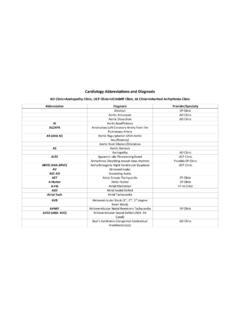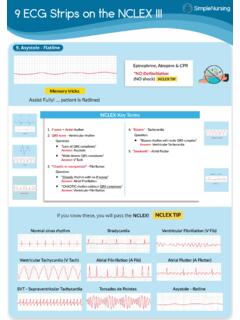Transcription of Review Packet EKG Competency 2016
1 1/2016 Review Packet EKG Competency 2016 This Packet is a Review of the information you will need to know for the proctored EKG Competency test. 1/2016 Normal Sinus Rhythm Parameters Rhythm: Regular Ventricular Rate: 60-100 bpm P Wave: upright, matching, 1:1 Atrial Rate: 60-100 bpm PR Interval: seconds QRS Interval: < seconds Etiology None Significance Normal Treatment None 1/2016 Sinus tachycardia Parameters Rhythm: Regular Ventricular Rate: 101-150 P Wave: upright, matching, 1:1 Atrial Rate: 101-150 PR Interval: seconds QRS Interval: < seconds Etiology Exercise Fever Hypoxia Hypovolemic Pulmonary embolism Myocardial ischemia Hypotension Caffeine Alcohol Nicotine Significance Increases myocardial oxygen demands, increasing the hearts workload o In an acute MI, this may lead to an increase in myocardial ischemia, angina, or extend the infarct o May also trigger ventricular dysrhythmia o May be a warning sign of right sided heart failure Shortens ventricular filling times which decreases stoke volume which affects cardiac output Treatment Find and treat underlying cause Monitor for signs of decreased coronary perfusion o Diaphoresis o Chest pain o Dyspnea 1/2016 Sinus Bradycardia Parameters Rhythm: Regular Ventricular Rate: < 60 bpm P Wave: upright, matching, 1:1 Atrial Rate.
2 < 60 bpm PR Interval: seconds QRS Interval: < seconds Etiology Normal for trained athletes An MI to the RCA Reperfusion Rhythm Elevated ICP Medications (beta-blockers, calcium channel blockers, digitalis) Degenerative diseases, such as sick sinus syndrome Vagal stimulation from vomiting, sleeping, nausea Significance Normal in healthy adults and athletes Can be beneficial in injured hearts to allow increased ventricular filling time and decreased myocardial oxygen demands Some individuals experience a significant decrease in cardiac output (HR x SV = CO) as well as blood pressure Treatment Treat only if SYMPTOMATIC: 1. IVP Atropine 2. Pacemaker Temporary transcutaneous or transvenous Chronic bradycardia may require a permanent pacemaker Discontinue any bradycardia inducing medications 1/2016 Sinus Arrhythmia Parameters Rhythm: Irregular Ventricular Rate: any rate P Wave: upright, matching, 1:1 Atrial Rate: any rate PR Interval: seconds QRS Interval: < seconds Etiology May be seen in young children and elderly Change in vagal tone due to respirations May also be caused by: Increased ICP Dig toxicity Inferior wall MI Significance None depending on rate If rate is bradycardic, may decrease cardiac output Treatment None, unless rate is bradycardic.
3 If patient is symptomatic with bradycardia: o IVP Atropine o Pacemaker 1/2016 Premature Atrial Contraction(PAC) Parameters Rhythm: that of underlying rhythm Ventricular Rate: that of underlying P Wave: upright, abnormal in size and shape, p wave may be in T wave Atrial Rate: that of underlying rhythm PR Interval: seconds QRS Interval: < seconds Etiology Can occur in normal hearts o Can be seen with emotional distress Heart disease Ingestion of alcohol, caffeine, or nicotine Hypoxia Myocardial ischemia Chronic lung disease Medications Significance Usually common and do not require treatment Frequent PAC s may warn of or intiate: o PAT o Atrial Fibrillation o Atrial Flutter Treatment Usually no treatment Remove underlying cause: o Nicotine o Alcohol o Caffeine 1/2016 Paroxysmal supraventricular tachycardia (PSVT or SVT) Parameters Rhythm: Regular Ventricular Rate: > 150 bpm P Wave: unable to see Atrial Rate: NA PR Interval: NA QRS Interval: < seconds Etiology Stress Caffeine Tobacco Alcohol COPD Digitalis Toxicity Significance Shortens ventricular filling time which can decrease stoke volume which can decrease cardiac output Increases myocardial oxygen requirements and cardiac workload Treatment If unstable: o Electrical Cardioversion If stable: 1.
4 Sedation 2. Vagal maneuvers 3. IVP Adenosine 4. Rate controlling medication such as a calcium channel blocker (ex. Diltiazem) or a beta blocker. 1/2016 Atrial Flutter Parameters Rhythm: Regular/Irregular Ventricular Rate: varies P Wave: flutter, sawtooth Atrial Rate: 250-350 bpm PR Interval: NA QRS Interval: < seconds Etiology Valvular heart disease Hypertensive heart disease Cardiomyopathy Heart failure Pulmonary disease Pulmonary emboli Post-cardiac surgery Significance If ventricular rate is rapid: o Ventricular filling time is shortened which can decrease stoke volume which can decrease cardiac output o Myocardial oxygen requirements and cardiac workload are increased If ventricular rate is slow: Decrease in cardiac output due to slow heart rate Stasis of blood in atria can lead to thrombus formation & possible arterial or pulmonary embolism Treatment If patient is stable and the rhythm has been present treatment depends on ventricular rate & patient symptoms: Amiodarone, Calcium Channel Blockers, Beta Blockers If unstable: Cardiovert immediately Goal is to restore sinus rhythm!
5 1/2016 Atrial Fibrillation Parameters Rhythm: Irregular Ventricular Rate: varies P Wave: not seen, fibrillatory waves Atrial Rate: >300 bpm PR Interval: NA QRS Interval: < seconds Etiology Valvular heart disease Hypertensive disease Coronary heart disease Cardiomyopathy Heart failure Hyperthyroidism Pulmonary disease Cardiac surgery Significance Same as atrial flutter. Treatment Same as atrial flutter Chronic atrial fibrillation (present for months or years) may not convert to sinus rhythm with any type of therapy. Typically no attempt is made to return chronic atrial fibrillation patients to sinus rhythm. 1/2016 Junctional Rhythm Parameters Rhythm: Regular Ventricular Rate: 41-60 bpm P Wave: inverted, absent, inverted after QRS Atrial Rate: 41-60 PR Interval: < seconds QRS Interval: < seconds Etiology SA node disease Myocardial infarction Dig toxicity Increase in vagal tone Significance AV junction not reliable as pacemaker for long periods The slow rate may cause: o Hypotension o Decrease in Cardiac Output Treatment Depends on tolerance of slowed heart rate Identify and treat underlying cause If symptomatic: 1.
6 Atropine IVP 2. Transcutaneous or transvenous pacing 1/2016 Accelerated Junctional Rhythm Parameters Rhythm: Regular Ventricular Rate: 61-100 bpm P Wave: inverted, absent, inverted after QRS Atrial Rate: 61-100 bpm PR Interval: < seconds QRS Interval: < seconds Etiology Dig toxicity Damage to AV node secondary to Inferior wall MI Heart failure Acute rheumatic fever Valvular heart disease Open heart surgery Myocarditis Significance Typically well tolerated For some the loss of normal atrial depolarization can cause a decrease in cardiac output. Treatment Treatment should be directed at identifying the underlying cause and correcting it. 1/2016 Junctional tachycardia Parameters Rhythm: Regular Ventricular Rate: >101bpm P Wave: inverted, absent, inverted after QRS Atrial Rate: >101 bpm PR Interval: < seconds QRS Interval: < seconds Etiology Dig Toxicity Damage to AV node (Inferior MI) Heart Failure Myocarditis Rheumatic Fever Significance If ventricular rate is rapid: o Ventricular filling time is shortened which can decrease stoke volume which can decrease cardiac output o Myocardial oxygen requirements and cardiac workload are increased Treatment Identify and treat cause Vagal Maneuvers If there is no apparent cause and the patient is symptomatic: o Diltiazem o Beta blockers o Amiodarone 1/2016 Premature Junctional Contraction Parameters Rhythm.
7 Usually regular Ventricular Rate: underlying rhythm P Wave: inverted, absent, or inverted after the QRS Atrial Rate: underlying rhythm PR Interval: < seconds QRS Interval: < seconds Etiology Alcohol Simulants: o Coffee o Tea o Tobacco Coronary artery disease Digoxin toxicity Inferior wall MI Significance Unusual in healthy adults Early sign of digoxin toxicity May precipitate junctional tachycardia Treatment Treat underlying cause 1/2016 Ventricular Fibrillation Parameters Rhythm: Chaotic Ventricular Rate: NA P Wave: NA Atrial Rate: NA PR Interval: NA QRS Interval: NA Etiology Most common cause of death for people with coronary heart disease Most common cause of sudden cardiac death in patients with an acute MI Other causes: Myocardial Ischemia Cardiomyopathy Hypoxia Cocaine toxicity Electrolyte imbalance Significance No organ perfusion!
8 Treatment Check for Pulse! (If there is a pulse, not VF.) If there is no pulse: 1. Defibrillation 2. CPR 3. Drugs: Epinephrine Amiodarone 1/2016 Ventricular tachycardia Parameters Rhythm: Regular Ventricular Rate: >101 bpm P Wave: none Atrial Rate: none PR Interval: NA QRS Interval: seconds Etiology Heart disease Myocardial ischemia or infarction Cardiomyopathy CHF Medications Hypoxia Electrolyte imbalance Significance Seriousness depends on duration, rate, and how well the heart functions Patients may have bursts of VT Sustained VT is a life-threatening arrhythmia Can progress to Ventricular Fibrillation Decrease or absence of Cardiac Output Treatment Assess Patient (pulse, BP, LOC) V. Tach with a pulse and: o Stable 1.
9 Amiodarone 2. Cardioversion o Unstable 1. Cardioversion V. Tach without a pulse: 1. Defibrillation 2. CPR (initiate immediately) 3. Epinephrine 4. Amiodarone 1/2016 Ventricular Standstill Parameters Rhythm: Atrial Regular Ventricular Rate: NA P Wave: upright, matching Atrial Rate: varies PR Interval: NA QRS Interval: NA Etiology Acidosis Hypoxia Hyperkalemia Hypothermia Drug Overdose 1/2016 Idioventricular Rhythm Parameters Rhythm: Regular Ventricular Rate: 21-40 bpm P Wave: NA Atrial Rate: NA PR Interval: NA QRS Interval: seconds Wide and Bizarre Etiology Disease or injury to the SA node or AV node Medications that can slow or inhibit the SA node or AV node May occur in brief intervals Advanced heart failure CHF Significance Decrease in cardiac output Commonly precedes asystole Sign of a dying heart Treatment Goal is to establish a reliable pacemaker and increase the heart rate Never attempt to obliterate an Idioventricular rhythm with antiarrhythmic drugs Treat with: o Atropine o Transcutaneous or Transvenous pacemaker o Dopamine for hypotension 1/2016 Accelerated Idioventricular Rhythm Parameters Rhythm: Regular/Irregular Ventricular Rate: 41-100 bpm P Wave: NA Atrial Rate: NA PR Interval: NA QRS Interval.
10 Seconds, Wide and bizarre Etiology Common following thrombolytic therapy Can be a transient rhythm May be a result of dig toxicity Significance Typically well tolerated May have decreased cardiac output at lower heart rates Treatment No treatment usually necessary Monitor the patient s hemodynamic values (blood pressure) 1/2016 Premature Ventricular Contraction Parameters Rhythm: underlying rhythm Ventricular Rate: underlying rhythm P Wave: absent on premature beat Atrial Rate: underlying rhythm PR Interval: none QRS Interval: seconds Etiology Anxiety Excessive caffeine/alcohol intake Drugs CHF Electrolyte imbalance (Hypokalemia, hypomagnesemia) Heart surgery Reperfusion after thrombolytics Significance PVC s are very common Become more frequent as we age Can precipitate life-threatening arrhythmias Treatment Treat the cause Medications Electrolyte replacement Decrease caffeine consumption 1/2016 Asystole Parameters Rhythm: NA



